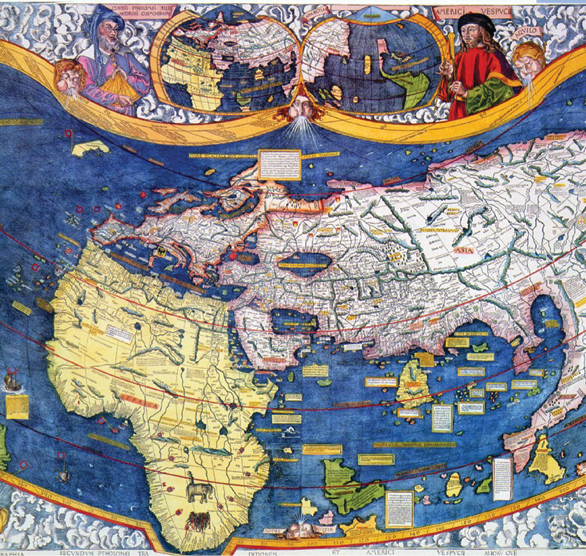12Contact, Commerce, and Colonization
1450–1600

Core Objectives
- DESCRIBE the broad patterns of world trade after 1450, and COMPARE major features of world trade in Asia, the Americas, Africa, and Europe.
- ANALYZE the factors that enabled Europeans to increase their trade relationships with Asian empires in the fifteenth and sixteenth centuries, and ASSESS their significance.
- COMPARE the practices and the impact of European explorers in Asia and the Americas.
- ANALYZE the social and political relationships, and EXPLAIN the sources of conflict within the Afro-Eurasian polities.
- ASSESS how European colonization of the Americas affected African and Amerindian peoples, and DESCRIBE their responses.
At the time of Christopher Columbus’s birth in 1451, the great world power on the rise was neither Spain nor Portugal, but the Ottoman Empire. For the Ottomans, unlike the other major Asian empires, the fifteenth and sixteenth centuries marked a period of frenzied territorial expansion in the Mediterranean as well as the Indian Ocean. The Ottomans sought to fulfill what they considered to be Islam’s primary mission: world dominion. Sultans Bayezid II (r. 1481–1512), Selim I (r. 1512–1520), and Suleiman the Magnificent (r. 1520–1566) continued the conquests of Mehmed the Conqueror and led the thrust into Arab lands and the Indian Ocean even while pressing ahead in Europe. Indeed, Selim I boasted that “he was the ruler of the east and the west.”
As the Ottomans turned their attention to conquest of the Red Sea, the Arabian Peninsula, and North Africa, reestablishing under their own control trade routes disrupted by the Mongols and the Black Death, they forced others seeking shares in South and East Asian luxuries to seek new sea passages. European states gave the Ottomans no cause for alarm when they began to make inroads in South Asia in the mid-sixteenth century. After all, it was not Ottoman territory they were contesting, and the Ottomans, looking westward, had bigger fish to fry. No one could have predicted that European conquests of a few South Asian trading cities were particularly significant, compared with the Ottomans’ relentless annexations of large territories, including great stretches of southeastern Europe.
Even more unpredictable, though hugely consequential, was the accidental discovery made by Christopher Columbus. Seeking to circumvent Ottoman power in the eastern Mediterranean, Columbus opened up a “New World” about which Afro-Eurasians had no previous knowledge. Although Columbus did not intend to “discover” America when he went looking for Asia, his voyages convinced Europeans that there were still new territories to exploit and peoples to convert to Christianity. For the first time since the Ice Age migrations, large numbers of people moved from Afro-Eurasian landmasses to the Americas. Two different biomes (distinct biological systems, including humans, that have formed in response to shared physical conditions) came into contact and converged, including plants, commercial products, and—most momentous—deadly germs. The encounter of the New and Old Worlds was as if two separate planets that had not known of each other suddenly merged into one. Europeans now began building empires different in kind from the land empires of Africa and Asia: overseas empires. While the new colonies generated vast riches, they also brought unsettling changes to the rulers and the ruled.
Despite the significance of Europeans’ activity in the Americas, most Africans and Asians were barely aware of the Americas. Asian empires continued to flourish after recovering from the Black Death. Nor was Europe’s attention exclusively on the Americas, for its royal houses competed with one another for power and territory at home. Religious revolt in the form of the Protestant Reformation intensified these rivalries. In the wake of Columbus, the drive to build and protect empires across oceans began a very long process that would profoundly change the terms on which people around the globe interacted with one another.
Global Storyline
The Age of Global Exploration and Colonization
- The European “discovery” of the Americas begins a complex process that changes the ways peoples around the world interact with one another.
- For the first time, major world empires are oceanic, overseas empires rather than continental empires.
- Despite the long-term significance of European activity in the Americas, most Africans and Asians are barely aware of the Americas or the expansion of long-distance trade.
- Within Europe, dynastic states concentrate attention and resources on their own internal rivalries. Religious revolts, especially the Protestant Reformation, intensify those rivalries.
- Asian empires thrive in the sixteenth century, thanks to commercial expansion and political consolidation.
Glossary
- biomes
- Distinct biological systems, including humans, that have formed in response to shared physical conditions.